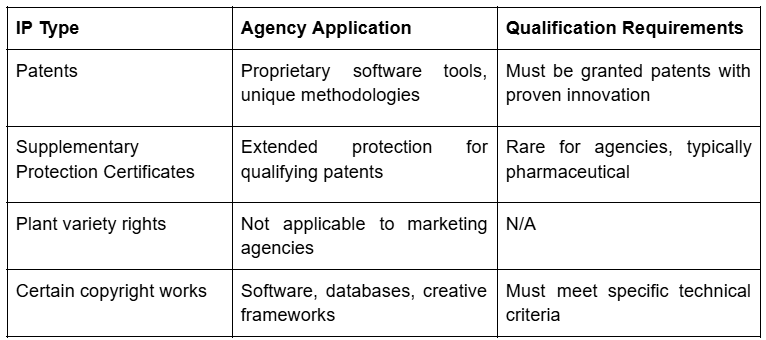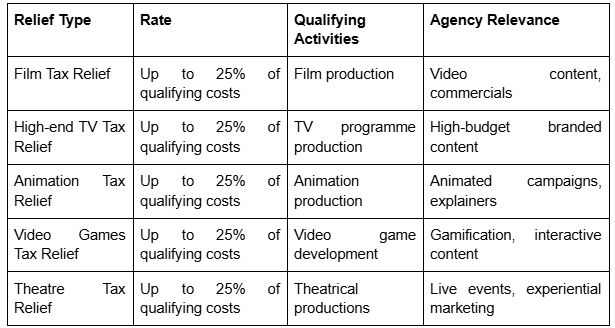Agency Intellectual Property Tax Relief

Your agency creates valuable intellectual property every day - from proprietary methodologies to creative campaigns. But are you claiming the tax relief you're entitled to on IP development costs and qualifying rights? Here's how to unlock significant savings through Patents Box and creative industry schemes.
The Hidden Value in Agency IP
Most agency directors think intellectual property tax relief doesn't apply to them. They assume it's only relevant for pharmaceutical companies or tech giants developing groundbreaking innovations. This misconception costs agencies thousands in missed relief opportunities every year.
The reality is that modern agencies create substantial intellectual property. Your proprietary campaign methodologies, branded frameworks, creative processes, software tools, and even certain types of content can qualify for significant tax advantages. The challenge lies in understanding what qualifies and how to structure your IP development to maximise relief.
HMRC's approach to IP relief has evolved significantly, particularly around creative industries and digital assets. Agency directors who understand these changes can reduce their effective corporation tax rate on IP profits from 25% to as low as 10% through the Patents Box regime, while also claiming development costs against current profits.
Patents Box for Agencies
The Patents Box regime allows companies to apply a reduced corporation tax rate of 10% to profits derived from qualifying intellectual property rights. While the name suggests it's only for patents, the regime actually covers a broader range of IP that agencies regularly create.
What Qualifies for Patents Box:

The key insight for agencies is that software development and certain systematic methodologies can qualify if they're properly protected and documented. Many agencies develop proprietary tools for campaign management, client reporting, or creative workflow optimisation without realising these could qualify for Patents Box treatment.
Patents Box Calculation Method:
The relief works by applying a formula that determines how much of your profits relate to qualifying IP. The calculation considers:
- Development expenditure you've incurred
- Acquisition costs for qualifying IP
- Overall company profits
- Proportion attributable to qualifying IP activities
For agencies, this often means demonstrating that specific revenue streams derive from your protected IP, whether that's licensing your methodology to other agencies or charging premium rates for proprietary service delivery.
Creative Industry Relief Schemes
Beyond Patents Box, several relief schemes specifically target creative industries, offering significant opportunities for agencies operating in content creation, digital marketing, and creative services.
Creative Industry Tax Credits:

These reliefs work as either corporation tax deductions or payable tax credits, meaning you can receive cash even if you have no corporation tax liability. For agencies producing qualifying content, this can represent substantial value.
Cultural Test Requirements:
Most creative industry reliefs require content to pass a "cultural test" demonstrating British cultural content. This typically involves:
- British or EU citizenship of key personnel
- UK-based production activities
- British cultural themes or settings
- Use of English language or UK regional languages
Many agency-produced campaigns naturally meet these criteria, particularly those created for UK clients or featuring British cultural elements.
IP Development Costs: What You Can Claim
The development costs associated with creating intellectual property often qualify for immediate tax relief, separate from any future Patents Box benefits. Understanding which costs qualify can significantly reduce your current tax liability.
Qualifying Development Expenditure:
Research and Development Activities:
- Staff costs for employees developing new methodologies
- Consumable materials used in IP creation
- Software and equipment used exclusively for development
- External contractor costs for IP development work
Creative Development Costs:
- Concept development and ideation costs
- Prototype creation and testing
- Market research specific to IP development
- Legal costs for IP protection and registration
The key distinction is between development costs (which qualify for relief) and exploitation costs (which typically don't). Development involves creating something new, while exploitation involves using existing IP to generate revenue.
R&D Tax Credits for IP Development:
Many agencies overlook R&D tax credits when developing intellectual property. The scheme offers enhanced deductions of 130% for large companies or payable credits for SMEs, making IP development significantly more affordable.
Activities that commonly qualify include:
- Developing new creative processes or methodologies
- Creating proprietary software tools or platforms
- Advancing creative techniques or technologies
- Systematic experimentation with new approaches
The relief applies even if your development work doesn't result in successful IP, provided you were genuinely advancing knowledge or capability in your field.
Software and Digital Assets: Modern IP Opportunities
Digital marketing agencies increasingly develop software-based IP that can qualify for substantial relief. This includes proprietary algorithms, automated systems, and innovative digital tools.
Qualifying Software Development:
Software qualifies for IP relief when it involves genuine innovation beyond routine programming. Examples include:
- Automated campaign optimisation algorithms
- Proprietary client reporting platforms
- Innovative creative workflow management systems
- Advanced analytics or data processing tools
The development must represent an advance in software functionality, not just customisation of existing platforms. Documentation proving innovation is crucial for defending claims during HMRC reviews.
Database Rights and Creative Frameworks:
Agencies often create substantial databases of creative assets, client insights, or market intelligence. These can qualify for copyright protection and potential IP relief, particularly when they involve:
- Systematic organisation of substantial amounts of data
- Original selection or arrangement of information
- Significant investment in obtaining or verifying data
- Commercial value derived from the database structure
Creative frameworks and methodologies can also qualify when they're sufficiently documented and protected through appropriate IP registration.
Record Keeping and HMRC Compliance
IP tax relief claims face heightened HMRC scrutiny due to their complexity and potential value. Proper documentation is essential for successful claims and audit defense.
Essential Documentation Requirements:
Development Records:
- Project plans and technical specifications
- Staff timesheets showing IP development work
- Invoices and receipts for development costs
- Meeting minutes documenting technical decisions
IP Protection Evidence:
- Patent applications and grant certificates
- Copyright registration documents
- Trade mark filings and approvals
- Confidentiality agreements and licensing terms
Commercial Exploitation Proof:
- Revenue attributable to IP usage
- Licensing agreements and royalty payments
- Marketing materials highlighting IP benefits
- Client testimonials referencing proprietary methods
Common Misconceptions and Missed Opportunities
Many agency directors miss IP relief opportunities due to misconceptions about eligibility and complexity.
"We Don't Do R&D"
Agencies often assume R&D relief only applies to scientific research. In reality, developing new creative processes, testing innovative approaches, or creating proprietary tools frequently qualifies.
"Our IP Isn't Valuable Enough"
Even modest IP portfolios can generate significant relief. The key is systematic identification and protection of qualifying assets rather than focusing only on major innovations.
"The Admin Burden Isn't Worth It"
While IP relief requires documentation, the potential savings often justify the administrative effort. Relief rates of 10-25% on qualifying activities represent substantial value for most agencies.
"It's Too Risky With HMRC"
Conservative interpretation of rules and proper documentation make IP relief claims defensible. The regimes exist to encourage innovation, and HMRC supports legitimate claims.
Claim Your IP Tax Relief
The landscape of IP tax relief offers substantial opportunities for agencies willing to invest in proper planning and documentation. Whether through Patents Box relief, creative industry credits, or R&D deductions, these regimes can significantly reduce tax liability while encouraging innovation.
The key is recognising that your agency likely creates more qualifying IP than you realise. From proprietary methodologies to creative frameworks, from software tools to systematic processes, modern agencies develop valuable intellectual property that deserves proper protection and tax optimisation.
Success requires treating IP development as a strategic tax planning opportunity, not just a byproduct of client work. With proper structure, documentation, and professional guidance, IP relief can become a significant contributor to your agency's financial efficiency and competitive advantage.
Considering IP tax relief for your agency?
Our team specialises in helping agencies identify qualifying activities and optimise relief claims while ensuring full HMRC compliance.
Book a strategy call to assess your IP portfolio and develop a comprehensive relief strategy.

.jpg)


